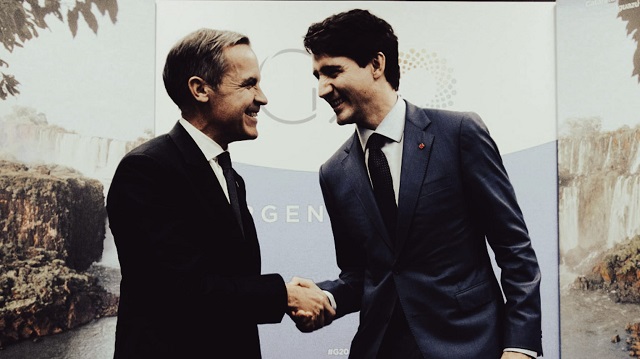Alberta
Danielle Smith partnering with Elon Musk’s Starlink to bypass federal internet censorship laws

Starlink satellite rendering
From LifeSiteNews
The Alberta government is working with SpaceX’s Starlink to avoid ‘federal government delays launching projects and allocating funding’ for internet access
The government of Alberta is partnering with Elon Musk’s SpaceX’s Starlink to bring internet to certain areas of the province to test the viability of the technology that Premier Danielle Smith said last year could be used as a firewall to bypass federal internet censorship laws.
Last Thursday, United Conservative Party (UCP) Minister of Technology and Innovation Nate Glubish announced that “advancing satellite internet technology in Alberta is an important milestone and an innovative way to achieve our goal of universal connectivity by 2027.”
Glubish said that connecting rural Albertans via Starlink is another way to “eliminate the connectivity gap.”
As a result, the Alberta government in a limited-time pilot is working with SpaceX’s Starlink to avoid “federal government delays launching projects and allocating funding” for internet access.
In June 2022 while was running for leadership of the UCP, Smith said that she would create a provincial internet firewall to bypass federal internet censorship laws with the possible help of Starlink.
“Hey @elonmusk I’m running to be the Premier of Alberta. We still value free speech here. Could Alberta set up an independent ISP using @starlink to bypass the new @justintrudeau internet censorship law,” Smith wrote.
Smith also included in her tweet last week a reminder of her message last year that said: “Did you know @JustinTrudeau’s new internet censorship law will mean Liberal partisans can pick and choose what Albertans can say and express on the Internet.”
“As Premier, I will protect the right of every Albertan to express their opinion – left, right and everything in between – without fear of Ottawa’s censorship.”
Musk’s Starlink is a satellite-operated internet provider that offers fast service from virtually anywhere in the world and is free from censorship.
Smith made the comments in light of the federal government’s internet censorship Bill C-11, the Online Streaming Act, which at the time was blasted by many as allowing the government more control of free speech through potential new draconian web regulations.
As for the Alberta Starlink pilot, it will see the government contribute $1,000 to each eligible household in the County of Forty Mile, County of Warner No. 5 and Cardston County.
The government says that the pilot will provide “feedback” for future programs regarding Alberta’s access to the internet.
Since 2019, SpaceX has launched 12,000 satellites over 60 countries to provide internet access.
As for the Trudeau government’s Bill C-11, it was passed last year. It mandates that the Canadian Radio-television and Telecommunications Commission (CRTC) oversee regulating online content on platforms such as YouTube and Netflix to ensure that such platforms are promoting content in accordance with a variety of its guidelines.
This bill has been panned by critics, Smith, and even Musk.
In October, after the CRTC said that certain podcasters must “register” with the government by November 28. In response, Musk said that “Trudeau is trying to crush free speech in Canada.”
Another Trudeau internet censorship law, Bill C-18, the Online News Act, became law in June despite warnings that it will end free speech in Canada. This new law forces social media companies to pay Canadian legacy media for news content shared on their platforms.
Smith has been in a prolonged battle with the Trudeau government over its extreme green energy policies that target Alberta, and no doubt should the Starlink trial go well, the government might look at ways to further shield Albertans from federal government overreach.
Smith’s political style leans toward libertarianism. She strongly opposed COVID mandates of all kinds, and after winning Alberta’s provincial election earlier this year, she promised to stand up for parental rights as well as to cut government bloat by taking away powers from unelected health officials.
Alberta
Low oil prices could have big consequences for Alberta’s finances

From the Fraser Institute
By Tegan Hill
Amid the tariff war, the price of West Texas Intermediate oil—a common benchmark—recently dropped below US$60 per barrel. Given every $1 drop in oil prices is an estimated $750 million hit to provincial revenues, if oil prices remain low for long, there could be big implications for Alberta’s budget.
The Smith government already projects a $5.2 billion budget deficit in 2025/26 with continued deficits over the following two years. This year’s deficit is based on oil prices averaging US$68.00 per barrel. While the budget does include a $4 billion “contingency” for unforeseen events, given the economic and fiscal impact of Trump’s tariffs, it could quickly be eaten up.
Budget deficits come with costs for Albertans, who will already pay a projected $600 each in provincial government debt interest in 2025/26. That’s money that could have gone towards health care and education, or even tax relief.
Unfortunately, this is all part of the resource revenue rollercoaster that’s are all too familiar to Albertans.
Resource revenue (including oil and gas royalties) is inherently volatile. In the last 10 years alone, it has been as high as $25.2 billion in 2022/23 and as low as $2.8 billion in 2015/16. The provincial government typically enjoys budget surpluses—and increases government spending—when oil prices and resource revenue is relatively high, but is thrown into deficits when resource revenues inevitably fall.
Fortunately, the Smith government can mitigate this volatility.
The key is limiting the level of resource revenue included in the budget to a set stable amount. Any resource revenue above that stable amount is automatically saved in a rainy-day fund to be withdrawn to maintain that stable amount in the budget during years of relatively low resource revenue. The logic is simple: save during the good times so you can weather the storm during bad times.
Indeed, if the Smith government had created a rainy-day account in 2023, for example, it could have already built up a sizeable fund to help stabilize the budget when resource revenue declines. While the Smith government has deposited some money in the Heritage Fund in recent years, it has not created a dedicated rainy-day account or introduced a similar mechanism to help stabilize provincial finances.
Limiting the amount of resource revenue in the budget, particularly during times of relatively high resource revenue, also tempers demand for higher spending, which is only fiscally sustainable with permanently high resource revenues. In other words, if the government creates a rainy-day account, spending would become more closely align with stable ongoing levels of revenue.
And it’s not too late. To end the boom-bust cycle and finally help stabilize provincial finances, the Smith government should create a rainy-day account.
Alberta
Governments in Alberta should spur homebuilding amid population explosion

From the Fraser Institute
By Tegan Hill and Austin Thompson
In 2024, construction started on 47,827 housing units—the most since 48,336 units in 2007 when population growth was less than half of what it was in 2024.
Alberta has long been viewed as an oasis in Canada’s overheated housing market—a refuge for Canadians priced out of high-cost centres such as Vancouver and Toronto. But the oasis is starting to dry up. House prices and rents in the province have spiked by about one-third since the start of the pandemic. According to a recent Maru poll, more than 70 per cent of Calgarians and Edmontonians doubt they will ever be able to afford a home in their city. Which raises the question: how much longer can this go on?
Alberta’s housing affordability problem reflects a simple reality—not enough homes have been built to accommodate the province’s growing population. The result? More Albertans competing for the same homes and rental units, pushing prices higher.
Population growth has always been volatile in Alberta, but the recent surge, fuelled by record levels of immigration, is unprecedented. Alberta has set new population growth records every year since 2022, culminating in the largest-ever increase of 186,704 new residents in 2024—nearly 70 per cent more than the largest pre-pandemic increase in 2013.
Homebuilding has increased, but not enough to keep pace with the rise in population. In 2024, construction started on 47,827 housing units—the most since 48,336 units in 2007 when population growth was less than half of what it was in 2024.
Moreover, from 1972 to 2019, Alberta added 2.1 new residents (on average) for every housing unit started compared to 3.9 new residents for every housing unit started in 2024. Put differently, today nearly twice as many new residents are potentially competing for each new home compared to historical norms.
While Alberta attracts more Canadians from other provinces than any other province, federal immigration and residency policies drive Alberta’s population growth. So while the provincial government has little control over its population growth, provincial and municipal governments can affect the pace of homebuilding.
For example, recent provincial amendments to the city charters in Calgary and Edmonton have helped standardize building codes, which should minimize cost and complexity for builders who operate across different jurisdictions. Municipal zoning reforms in Calgary, Edmonton and Red Deer have made it easier to build higher-density housing, and Lethbridge and Medicine Hat may soon follow suit. These changes should make it easier and faster to build homes, helping Alberta maintain some of the least restrictive building rules and quickest approval timelines in Canada.
There is, however, room for improvement. Policymakers at both the provincial and municipal level should streamline rules for building, reduce regulatory uncertainty and development costs, and shorten timelines for permit approvals. Calgary, for instance, imposes fees on developers to fund a wide array of public infrastructure—including roads, sewers, libraries, even buses—while Edmonton currently only imposes fees to fund the construction of new firehalls.
It’s difficult to say how long Alberta’s housing affordability woes will endure, but the situation is unlikely to improve unless homebuilding increases, spurred by government policies that facilitate more development.
-

 2025 Federal Election23 hours ago
2025 Federal Election23 hours agoMark Carney: Our Number-One Alberta Separatist
-

 2025 Federal Election1 day ago
2025 Federal Election1 day agoNine Dead After SUV Plows Into Vancouver Festival Crowd, Raising Election-Eve Concerns Over Public Safety
-

 Opinion2 days ago
Opinion2 days agoCanadians Must Turn Out in Historic Numbers—Following Taiwan’s Example to Defeat PRC Election Interference
-

 International1 day ago
International1 day agoJeffrey Epstein accuser Virginia Giuffre reportedly dies by suicide
-

 International2 days ago
International2 days agoHistory in the making? Trump, Zelensky hold meeting about Ukraine war in Vatican ahead of Francis’ funeral
-

 C2C Journal2 days ago
C2C Journal2 days ago“Freedom of Expression Should Win Every Time”: In Conversation with Freedom Convoy Trial Lawyer Lawrence Greenspon
-

 2025 Federal Election1 day ago
2025 Federal Election1 day agoColumnist warns Carney Liberals will consider a home equity tax on primary residences
-

 2025 Federal Election15 hours ago
2025 Federal Election15 hours agoCanada is squandering the greatest oil opportunity on Earth


